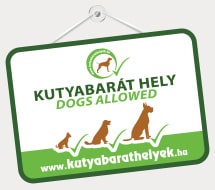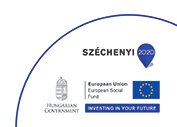The expert on dog-friendly places
dogfriendlyplaces.eu
Komondor

Komondor
The Komondor is an oldestablished Hungarian herding breed of Asiatic origin. His original ancestors almost certainly came with the migrating Old Magyars, living as stock-breeding Nomads, to the Carpathian basin.
FCI-Standard N° 53
KOMONDOR
Origin: Hungary.
Utilisation: Herding dog.
FCI-Classification:
- Group 1 Sheepdogs and Cattle Dogs (except Swiss Cattle Dogs).
- Section 1 Sheepdogs.
- Without working trial.
Brief Historical Summary:
- The Komondor is an oldestablished Hungarian herding breed of Asiatic origin. His original ancestors almost certainly came with the migrating Old Magyars, living as stock-breeding Nomads, to the Carpathian basin.
General Appearance:
- The Komondor is large in size and powerfully built. His appealing outward appearance and dignified deportment arouse respect and even fear in the observer. By nature he is not ingratiating. His robust body is covered by matted, corded, throughout dense, long hair. The body, seen sideways, forms a prone rectangle, little deviating from a square. The thickly coated head rises above the body. The tail is carried hanging down with its tip bent upwards, almost horizontal. The coat colour is ivory.
Important Proportions:
- The body length sligthly exceeds the height at the withers.
- The deepest point of the brisket is approximately on a level with half of the height at the withers.
- The muzzle is slightly shorter than half of the length of the head.
Behaviour / Temperament:
- He has an imperturbable courage in the guarding and defense of the herds entrusted to him and the property and home of his master. He attacks silently and duringly. He regards his territory as his own property and will not tolerate any other living creature in it. His nature is suspicious. During the day, he likes to keep a lying position enabling him to control his area. At night, he is always on the move.
BODY STRUCTURE
1. Head
- Broad, in good proportion to the body. Even the dense screen of hair does not make him appear out of proportion.
- CRANIAL REGION:
- Skull: Domed, brows well developed.
- Stop: Well developed but not too steep.
- FACIAL REGION:
- Nose: Straight, cut off blunt, black.
- Muzzle: Not pointed; bridge of nose straight.
- Lips: Black, tightly fitting to mouth and jaw bones. Corner of mouth jagged.
- Jaws/Teeth: Jaws very well muscled, strong and powerful. Even and complete scissor bite, according to the dentition formula.
- Cheeks: Broad, of medium length.
- Eyes: Horizontally set, dark brown. The black rim tightly fitting to the eyeball.
- Ears: Set medium high on the domed skull. Clearly pendant from the base and V- or U-shaped. Not raised neither when alert nor in attack.
2. Neck
- Very well muscled. Should form an angle of 35 degrees to the horizontal. In quiet or peaceful situations, it is carried almost in continuation of the backline. Rather short than of medium length. Without dewlap or neck ruff.
3. Body
- Topline: Those parts of the body which form the topline are broad and very well muscled.
- Withers: Sufficiently long, clearly defined in front.
- Back: Short.
- Loin: Of medium length.
- Croup: Broad, of medium length, slightly sloping.
- Chest: Broad, well muscled. Brisket of medium depth, broad, long.
- Underline: Slightly tucked up.
4. Tail
- Low-set, clearly pendant; tip of the tail shows a slight bend, almost to horizontal. It is desirable that the tail reaches to the hock. When alert, the tail is raised, at most, to the level of the back.
5. Limbs
- FOREQUARTERS:
- Judging of the limbs is highly affected by the long corded coat.
- Front legs are columnar and straight, parallel and vertical seen from the front or the side.
- The chest is broad which results in wide apart, strong and free moving legs.
- The limbs are firmly connected to the body.
- Bone substance is strong and powerful.
- Joints are large.
- Shoulders: The shoulder blades are moderately sloping. Points of the shoulder blades placed vertically over the deepest point of the chest.
- Forefeet: Large, strong with well knit toes. Pads are slate grey, thick and well padded. Toenails grey.
- HINDQUARTERS:
- The position of the hind legs supports the body with medium angulations. Continuing the croup of medium length, broad, well muscled limbs are required.
- Upper thigh: Strongly muscled, voluminous.
- Hind feet: Longer than forefeet, otherwise similar.
- Dewclaws to be removed.
6. Gait / Movement:
- Light, free and even. The stride is wide and ground covering.
7. Skin
- The skin contains a lot of pigment and is slate grey. Dark pigment at the gums and the roof of mouth preferred. Diminished pigment and pink skin undesirable.
8. Coat
- Hair: The whole body is covered by long hair. The coat consists of a coarser topcoat and finer undercoat. The characteristic coat is determined by the relation of the top coat to the undercoat. The shaggy coat, that tends towards matting is a basic requirement. An equally dense, wavy, corded coat also occurs. The smaller tufts of hair are less or not matted at all. The coat is longest on the croup, at the loin region and on the rear of the upper thighs (at least 20-27cm). On the back, at the sides of the chest and at the region of the shoulder blades, it is of medium length (15-22 cm), at the cheeks, the eyebrows, on top of the head, on the ears, the neck and the limbs, it is shorter (10-18 cm) and at the lips and on the lower parts of the limbs shortest (9-11 cm). Neither a combed nor a completely neglected coat are desirable.
- Colour: Ivory colour.
9. Size and Weight
- Height at the withers:
- Dogs: Minimum 70 cm.
- Bitches: Minimum 65 cm.
- Weight:
- Dogs: 50 – 60 kg.
- Bitches: 40 – 50 kg.
- The breed shows few faults in type and is largely uniform as it has always been bred with the same target.
10. Faults
- Any departure from the foregoing points should be considered a fault and the seriousness with which the fault should be regarded should be in exact proportion to its degree and its effect upon the health and welfare of the dog. In particular: Lack of pigment on noseleather, eyes and rims of lids. Loose eyelids. Ring Tail.
11. Disqualifying Faults
- Aggressive or overly shy.
- Any dog clearly showing physical or behavioural abnormalities shall be disqualified.
- Flabby construction, body lacking muscle.
- Entropion, Ectropion.
- Overshot or undershot, wry mouth.
- Pricked, light ears.
- Short tail (ending 3 cm above hock).
- Heavy limbs and faulty movement.
- Not ivory coloured or multicoloured coat.
- Diversion from lower height limit as mentioned in the standard.
N.B.:
- Male animals must have two apparently normal developed testicles fully descended into the scrotum.
- Only functionally and clinically healthy dogs, with breed typical conformation, should be used for breeding.












